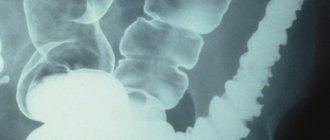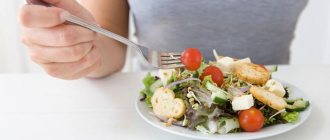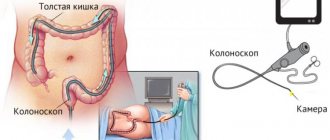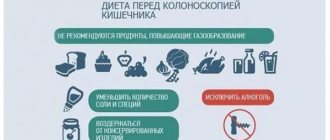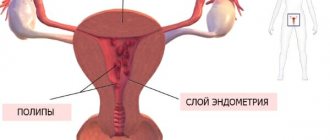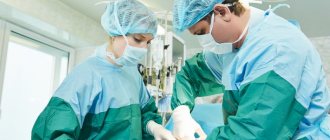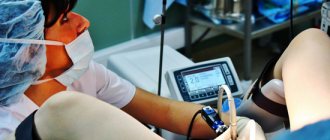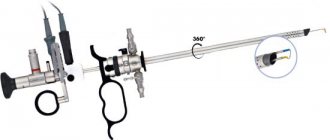Colonoscopy and diet
The intestines also have a mucous membrane. If polyps are detected on it, the growths are removed by colonoscopy. In this case, the intestines experience stress, which is caused by the introduction of a foreign object (tube with a nozzle). The procedure is unpleasant and requires further recovery.
As a means of rehabilitation, doctors offer a dietary diet. The diet should help renew the mucous membrane and normalize the functioning of the digestive system. Eating food without restrictions leads to serious complications that may require additional treatment.
The duration of the diet after removal of polyps in the large intestine is 7 days.
Before a colonoscopy, you also need to prepare your body. A special diet will help make the procedure less traumatic. The purpose of the diet: removal of toxins, rotting products, waste from the intestines.
Diet after removal of intestinal polyps by colonoscopy and polypectomy (what is it)
Colonoscopy is an instrumental endoscopic examination recognized by experts aimed at studying the patient’s colon and rectum.
As a result of the examination, the doctor can not only diagnose various gastrointestinal diseases, but can also immediately remove small benign neoplasms.
However, we should not forget that preparation and proper rehabilitation play a big role in carrying out this medical procedure. So, following a diet after removing polyps in the intestines by colonoscopy will enable the patient not to repeat surgical interventions.
What is a polyp and the causes of formation in the intestines
A polyp is a neoplasm on the walls of various organs. They come in round and mushroom shapes. Depending on the form, a specialist will perform a polypectomy. So, with a round shape, its base occupies a large area of the mucous tissue of the organ. At the base of the formation there is a large number of nerve endings and blood vessels, which complicates manipulations to remove it.
The size ranges from a few millimeters to 3-5 centimeters, and the growth is quite rapid, which often becomes the reason for untimely diagnosis and further degeneration of the polyp into a malignant formation.
Initially, polyps are not malignant formations, but statistics confirm that in the absence of appropriate treatment and control, cells can grow into malignant tumors. Therefore, at present, when diagnosing polyps of the colon and other organs, specialists recommend removing them immediately.
Types of polyps:
- hyperplastic - appear from the mother cells of the mucous tissue of the organ as a result of various factors;
- neoplastic - formed not from maternal cells;
- inflammatory or formed after various inflammatory processes on the mucous membrane of the organ.
Causes of polyps in the intestines:
- sedentary lifestyle;
- harmful habits;
- poor nutrition;
- microflora disturbance;
- stress;
- heredity;
- viral diseases
What is polypectomy and the need for it?
Polypectomy is an operation to remove polyps from the mucous tissues of organs.
The basis for polypectomy will be the identification of a polyp, the presence of which will be confirmed during the following studies:
- colonoscopy;
- laparoscopy;
- gastroscopy;
- irrigoscopy;
- sigmoidoscopy;
- MRI;
- CT scan.
When examining a patient's colon and rectum, the most informative method is, of course, a colonoscopy. One of the advantages of this procedure is that polypectomy is performed directly during the study. So, if a sufficiently large formation is found, it can be removed immediately.
Recent statistical data confirm the degeneration of benign neoplasms on the tissues of the patient’s organs into malignant tumors in 30 percent of cases. Therefore, timely removal of minor formations can save the patient’s life.
How to remove polyps in the intestines during colonoscopy
When performing a polypectomy during a colonoscopy, during which the specialist decided to remove the detected tumor, you should know that:
- removal is possible only if the size of the formation does not exceed 3 centimeters;
- excision of polyps during colonoscopy is possible if the specialist is sure that the formation is benign, otherwise the patient will be prescribed laparoscopy or abdominal surgery;
- in case of multiple formation of polyps on the tissues of the organ, their removal cannot be carried out during colonoscopy. Here, too, the patient will be prescribed a more serious surgical intervention;
- if the study reveals a large area of affected tissue in one or more organs, organ resection may be prescribed.
Stages of colonoscopy with polyp removal:
- If the presence of polyps is detected before a colonoscopy, then before the colonoscopy the patient will first need to drink a sodium bicarbonate solution, which will help the specialist see the intestinal walls without mucus.
- A colonoscope is inserted into the anus with a constant supply of air, which smoothes the intestinal walls.
- Upon reaching the site of growth formation, the specialist manipulates the colonoscope, as a result of which a rigid metal loop from the colonoscope captures the foreign formation and excises it.
Interesting! In the event that the polyp is round in shape, a stalk, which can be grasped by a loop from a colonoscope for further removal of the formation, is made artificially
Colonoscopy with removal of polyps with and without anesthesia
Removing a polyp during colonoscopy is a simple operation that can save the patient’s life. Patients are often interested in how an endoscopic examination is performed with anesthetic anesthesia or under general anesthesia.
Initially, a colonoscopy is performed under local anesthesia, since this is an unpleasant invasive procedure for the patient. However, if during the study, the need to remove polyps in the intestines is identified, only the proctologist conducting the study will be able to determine whether it is worth continuing the operation with or without anesthesia.
The feasibility of performing a polypectomy with anesthesia must be justified, since if large tumors are detected, the patient will most likely be prescribed laparoscopy or abdominal surgery.
How often should a colonoscopy be done after a polypectomy?
Colonoscopy with the removal of polyps is a rather complex procedure that can lead to a number of complications. However, if the patient answers a number of questions for himself, it will be easier for him to achieve a healthy and safe life.
How often should a colonoscopy be done? Only a specialist can answer this question, since there can only be an individual approach. On average, after a polyp is discovered in a patient’s body, he will be required to undergo examinations at least every 3-6 months for the first two years in order to avoid recurrence of polyp formation.
Possible complications
After removal of a polyp during colonoscopy, the following complications are possible, which the specialist should inform the patient about before performing the surgical procedure:
- bleeding - since the operation to remove formations on the mucous tissues of organs involves excision of foreign tissue, minor bleeding is possible;
- diarrhea - can be the result of long preparation with the use of laxatives and enemas;
- constipation – due to a disturbance in the body’s microflora, the patient may experience complications during bowel movements;
- pain – the return to normal life after a colonoscopy should be smooth and gradual, since due to non-compliance with a number of rules for the recovery period after a colonoscopy, pain in the lower abdomen may occur.
- increased temperature - any inflammatory process in the patient’s body indicates that more detailed monitoring of the condition is required.
If the patient experiences any postoperative discomfort or pain, he should consult a specialist.
Recovery period and dietary features after colonoscopy with polyp removal
After intestinal colonoscopy, rehabilitation is of particular importance, which includes:
- monitoring of the patient’s condition by specialists;
- maintaining a proper diet;
- therapeutic physical activity, which should be gentle;
- Maximum stress reduction.
The first week after colonoscopy, it is allowed to include in the diet only crushed food, jelly and jellies, broths and steamed lean meat, milk with honey and teas.
The main rule for the treatment table in the first days after an endoscopic examination is low fiber content.
So, for example, fruits and berries are recommended for consumption only at least a week after polypectomy.
In the first month after removal of polyps, the patient should be careful about food preparation methods, since the dish should not be greasy or heavy, otherwise it may cause discomfort and pain. It can also affect the reappearance of tumors in the body.
Nutrition after removal of polyps is very important, since the patient’s main task for the first few years after polypectomy should be maximum maintenance of his body and the possibility of complete restoration of intestinal tissue.
You should not drink alcohol and it is recommended to completely give up bad habits.
Among other things, the doctor may recommend herbal decoctions to the patient:
| Name of medicinal herbs | Method of preparing the decoction | Reception frequency |
| Celandine | A teaspoon of leaves is added to boiling water (200 ml), simmer for 20 minutes. | Take twice daily |
| Horseradish rhizome | Grated horseradish is mixed with honey in a 1:1 ratio | Every morning, on an empty stomach |
| Fragrant collision | The ground conflict is mixed with three glasses of water and left for two weeks. | Before every meal |
The recovery period after a colonoscopy with removal of tumors in the intestine can last up to two years. During this period, the patient is strongly advised to follow rules that can save his life.
Source: https://DiagnozPro.ru/skopiya/colonoscopy/udalenie-polipov
Recommendations and rules of nutrition
The diet should be followed 3-5 days before a colonoscopy and 7 days after removal of intestinal polyps. It is recommended to eat multiple meals throughout the day (6-7 times). At the same time, portions are reduced to prevent stress on the digestive system and gastrointestinal tract.
The choice of products should be conscious to avoid damage to the intestinal walls and other digestive organs. A properly composed menu guarantees the production of protective mucus. Useful micronutrients help restore local immunity. Increasing protective functions is an effective weapon against infections, secondary infection and bleeding.
It is especially important to maintain a drinking regime after removal of polyps by colonoscopy. Throughout the day, water is consumed in equal portions of 200-250 ml. The daily norm is 2-2.5 liters, if there are no contraindications due to general health.
When developing a menu, you need to take into account the basic principles of the diet:
- Portions are formed in a smaller volume. This will ensure gentle functioning of the digestive tract. You should avoid taking the supplement; overeating can lead to complications.
- Meals should be planned for a specific time with approximately equal breaks. This way the gastrointestinal tract will function evenly, having the opportunity to rest.
- Products are selected from those that are easily digestible. They should be rich in proteins and mineral salts. Preference should be given to ingredients that have an alkaline environment. Acids in large quantities provoke certain protective reactions of the body, which have a negative impact on the functioning of the digestive system and gastrointestinal tract.
- It is worth choosing from the methods of heat treatment of food: steaming, stewing, baking in the oven, regular cooking. Fried foods are not included in the diet plan.
- The temperature of the food should not exceed 60 degrees. The intake of cold drinks and foods is excluded. The higher the difference between the temperature regimes of food and the body, the higher the degree of irritation to the mucous membrane.
- 20-30 minutes before meals you need to drink purified water (200 ml). This promotes the rapid breakdown of food products and their gentle passage through the intestines.
The diet menu after a colonoscopy is compiled according to the principle: more vitamins, minimum fat. In addition to developing a diet, you need to introduce physical exercise into your daily routine. Morning or evening jogging and exercises with elements for the abs and pelvic organs are suitable.
An active lifestyle helps to quickly cleanse the intestines of processed products and toxins. Microenemas are also recommended.
Diet after removal of intestinal polyps by colonoscopy
Colonoscopy is a minimally invasive diagnostic method that involves the examination and treatment, if necessary, of various intestinal diseases.
After therapeutic and diagnostic manipulation, mandatory rehabilitation is required, as with a full-fledged intervention, which includes a special diet after removal of intestinal polyps by colonoscopy.
What can you eat to ease the burden on your digestive system?
The need to follow a diet after removal of a polyp in the intestine
The main goal of a therapeutic diet is to significantly reduce the load on the digestive system. After removal of polyps (more about intestinal polyps here), a gentle regimen is also required to prevent constipation, the formation of fecal stones, suture rupture and bleeding.
Other goals of the diet include the following aspects:
- Reducing or completely preventing gas formation;
- Decreased peristalsis of the intestinal muscles;
- Ensuring rapid digestion of food;
- Prevention of damage to the mucous membrane by coarse fibers and undigested pieces of food.
The duration of therapeutic nutrition is determined by the volume of surgical manipulation.
So, if a polypectomy of the rectum, colon, sigmoid or colon was performed, then the recovery period increases significantly, including diet.
How to eat?
If after a diagnostic colonoscopy patients immediately return to their previous lives, then after therapeutic and diagnostic manipulations it is necessary to follow the correct diet. On the first day after the manipulation, you should completely abstain from food. At this time, it is recommended to drink warm, clean water and an unsweetened decoction of rose hips.
Note : if you feel hungry, you can drink thick jelly. Adapted infant formula is especially nutritious. You can buy a pack and drink it like regular milk.
If after a few days the patient’s condition has improved, then you can gradually switch to a balanced, nutritious diet.
So, there are several main steps:
- 1-2 days - dairy-free mucous porridges, drink plenty of fluids;
- 3-5 days - milk porridge, dairy-free, crackers, soups with low-fat broth, drinking plenty of fluids;
- 6-10 days - pureed fruits, minced meat, fish are added.
After polypectomy, all food should be ground. If it’s fruit, then fresh juice or puree; if it’s cutlets or meatballs, then the minced meat should be twisted several times.
It is recommended to steam the food or eat it boiled. It is unacceptable to eat fresh berries, fruits and vegetables due to the large amount of coarse fiber.
Despite the obvious benefits, fiber damages the wound surfaces of the intestine, promotes their stretching, and therefore the risks of bleeding, infection, and complications are high.
The stool should be naturally softened and should not accumulate in the intestinal structures. It is allowed to drink fermented milk products, however, if possible, in the first days after polypectomy it is important to avoid whole milk, cottage cheese, and carbonated drinks containing whey.
The diet is dosed and frequent. The volume of one serving should not exceed 300 ml for an adult.
Note ! Ideally, the patient should constantly feel slightly hungry, but at the same time feel light, as if “deflated.” The food is always warm, neither cold nor hot. This will eliminate the risk of additional intestinal trauma.
What you can eat - allowed foods
Warm steam food can significantly reduce the load on the intestines, directing all the body's forces to healing the intestines. After excision, it is necessary to take protein foods (necessarily simple proteins).
Must be included in the menu:
- soft-boiled or raw chicken eggs (subject to own farming);
- steam omelette;
- walnuts, hazelnuts, grated into powder (1 tablespoon per day);
- lean poultry (chicken, turkey);
- fish products and seafood (squid, mussels, shrimp, scallops);
- low-fat dairy and fermented milk products;
- cereal porridge, well boiled;
- gelatinous products.
Drinks to be preferred:
- green tea,
- jelly,
- decoction of rose hips,
- herbal decoction.
It is necessary to drink up to 2 liters of clean water and other liquids per day.
Special instructions
At the same time, you should pay attention to your own health. With the doctor's permission, you can start light exercises and short walks. Smoking and drinking alcoholic beverages is prohibited. Eliminate confectionery and flour products or significantly limit consumption to 2 times a week.
Heavy foods and complex foods burden the digestive process, stimulate fermentation and gas formation, which will certainly negatively affect the condition of the epigastric organs.
Sample menu
Nutrition after intestinal colonoscopy does not require refined foods, and therefore is quite affordable, and also healthy. So:
- Day 1 : steam omelette, glass of green tea; for lunch, noodle soup with chicken broth, boiled beet salad with sour cream; crackers for an afternoon snack, mashed potatoes for dinner with a steamed cutlet.
- Day 2 : semolina porridge, cheese, black tea with milk without sugar; soup from any cereal with sour cream, croutons, vinaigrette; jelly and a glass of jelly for an afternoon snack; breaded chicken chop and rice.
- Day 3 : in the morning boiled buckwheat porridge, a glass of tea; soup with meatballs, fresh cucumber salad with sour cream; for an afternoon snack, a bun with milk; for dinner, beef chop with boiled potatoes.
- Day 4 : morning - steam omelette with herbs; lunch - borscht without meat with sour cream, boiled beet salad with prunes; for an afternoon snack, cookies and a glass of cranberry juice; For dinner, steamed fish cutlet with cheese.
- Day 5 : rice porridge with honey; for lunch, noodle soup with chicken broth, vinaigrette, croutons; for an afternoon snack, drinking yogurt; dinner - macaroni and cheese.
On weekends, you can carry out cleansing procedures using water, juices, and medicinal herbal decoctions.
Additional information on how to behave after removal of intestinal polyps to minimize the risks of complications in this video:
Diet after removal is an important aspect of successful recovery. Along with drug therapy, proper nutrition significantly alleviates the patient’s condition and speeds up the rehabilitation period. Compliance with all the doctor’s requirements reduces the risks of any complications.
Read about methods for removing adenomatous polyp of the rectum in this article.
You can make an appointment with a doctor directly on our website.
Be healthy and happy!
Diet after removal of intestinal polyps by colonoscopy - when and what can you eat? Link to main publication
Source: https://polipunet.ru/lechenie/dieta/posle-udaleniya-polipov-v-kishechnike-kolonoskopiej
Permitted and prohibited products
When compiling a diet menu, you should pay attention to foods that are easily digested without increasing gas formation. Nutritionists advise giving preference to the following dishes:
- crumbly porridge with water;
- cereal casseroles;
- vegetable soups;
- low-fat broths with veal or poultry meat;
- stewed vegetables;
- boiled meat dishes;
- steamed lean meat and fish;
- fresh fruit (not sour);
- egg dishes (boiled, omelet);
- dried fruits, nuts;
- fermented milk products (fat content within 2.5%);
- herbal drinks, decoctions, green teas.
For preparing dishes, it is recommended to use mainly fresh vegetables (zucchini, broccoli, tomatoes, eggplant, carrots, etc.). Adding to the menu:
- fish and meat (lean);
- homemade sour cream and cottage cheese;
- fresh herbs;
- eggs;
- fresh fruits, non-acidic berries;
- dried fruits (dried apricots, prunes, figs);
- liquid honey, etc.
The consumption of confectionery products is limited, but if desired, you can eat a little marshmallow or marmalade.
The strict diet is valid 2 days before surgery and 2-3 days after colonoscopy. Next, the remaining products are gradually introduced.
You can diversify your diet after removing polyps in the intestines with different foods, the main thing is to exclude the prohibited set. Restrictions apply to the following types of food:
- meat, fatty fish;
- smoked and fried foods;
- pickles, pickled and canned preparations;
- bean porridge (beans, peas, chickpeas, beans, etc.);
- some cereals (spelt, rice, pearl barley, sago);
- White cabbage;
- spices (garlic, onions, etc.), spices, ready-made sauces, ketchup;
- coffee, black tea, cocoa;
- semi-finished products;
- fresh bakery;
- confectionery.
The bans apply to alcohol, soda, packaged juices and tobacco products.
What diet should you follow after removal of intestinal polyps by colonoscopy?
In order to effectively recover from intestinal surgery, you need to rationally follow a specific nutrition plan. Such a plan will help avoid possible complications. A diet after removal of intestinal polyps by colonoscopy not only helps to undergo rehabilitation faster and more correctly, but also to prevent new formations.
What is special about the diet?
The types of food allowed for consumption after removal of polyps are collectively called table No. 0. Yes, the menu is limited. The post-polypectomy diet allows the consumption of only certain foods prepared in a special way. But it's worth it.
As a method of removing tumors, colonoscopy is a more gentle and simpler operation than other methods. Despite this, some damage is still caused, and the mucous membrane needs to be restored.
After the mucous membrane has healed, it will be possible to switch to a normal diet, but during rehabilitation you should be very careful, because irritation can cause complications.
A diet after removal of intestinal polyps by colonoscopy, on the contrary, will speed up recovery and allow you to switch to your usual diet much faster.
The diet looks exactly the same after removal of a polyp in the rectum - you should follow all the recommendations listed.
Three parts diet
The regimen during rehabilitation after this operation is quite simple. It includes three periods.
After the procedure, a diet is prescribed after removal of polyps in the intestines, the first days of which will be the most restrictive. This period lasts three days. The first day you will have to do without food at all - you cannot eat any food or drink.
The next day you are allowed to drink, and in the evening you can eat; broth or low-fat soup is allowed. On the morning of the third day you can have a decoction of rice and jelly. There is no other way - the complex healing process of the intestinal wall can be easily disrupted if bile or digestive juice gets into the intestine.
Recovery will take much longer.
The second part lasts from the 4th to the 14th day. Liquid porridges and soups are allowed here. If the patient has increased gas formation, the nutritionist will develop alternative dishes. The goal of the second stage is to gradually increase the load on the intestines.
The third part of the diet lasts from the 14th day to the fourth month inclusive. Here you will also have to sit on semi-liquid porridges and soups. You can add solid food, provided it is low-fat. Foods high in fiber are absolutely excluded.
The main condition for all dishes that the diet allows after removal of polyps in the intestines is a high content of proteins and amino acids in the absence of coarse fiber and irritants. The best dishes for this are soups with meat broth, milk products and easily digestible cereals.
What is acceptable and what is not allowed to eat?
Only diet will help restore the intestines; after removal of the polyp, the intestinal walls will take a long time to heal, and what you eat can affect the speed of recovery.
The food should contain a large amount of vitamins and microelements, but at the same time it should not interfere with healing or irritate damaged intestinal walls.
And the damage can be large, especially if there is more than one polyp.
Let's start with what not to eat. First, you should eliminate the most powerful irritants, such as fresh fatty milk, hot spices, coffee, and carbonated drinks. The prohibited list includes smoked products, semi-finished meat products, hard vegetables, such as cabbage, beans, baked goods, marinades, mushrooms, and canned food. Any solid foods such as grains or nuts are also excluded.
What is recommended to eat? The main dish - porridge - is quickly and easily digested, butter and vegetable oil, tea. Cottage cheese, low-fat kefir, sour cream and cheeses are allowed. You can also add lean meat, boiled or steamed, fish, rye bread and fruit.
It is important to remove seemingly harmless milk and millet from the menu, especially in the first few days. After the initial two weeks they can be returned.
Your doctor may recommend enzyme tablets to take before meals. They facilitate the digestion of food and accelerate the absorption of vitamins and nutrients into the blood.
Each organism is individual. The patient's condition depends on his immunity. In some cases, the doctor allows you to supplement your diet with other dishes that are sources of vitamins, proteins and antioxidants.
Then the diet after removal of the intestinal polyp by endoscopic method allows you to include fats in adequate quantities. These should be healthy fats; red fish and dairy products are allowed. Approximately the same dishes and products are prescribed by a doctor for other gastrointestinal problems.
The diet after removal of a polyp in the cecum looks exactly the same.
Some tips
After surgery, follow several rules, regardless of how much time has passed since surgery:
- Establish a new diet to reduce the amount of work your intestines do. To do this you will have to eat at least five times a day. We do this to avoid feelings of hunger, which stimulates the secretion of gastric juice. Namely, gastric juice irritates the intestinal walls. The intervals between meals should not exceed more than three hours. Between lunch and afternoon snack, you can take a little olive oil, which facilitates digestion and has a beneficial effect on the gastrointestinal tract as a whole;
- consume as much protein as possible. Surgery is a big stress for the body. The immune system will work harder, and the body needs adequate nutrition. Therefore, it is necessary to take additional protein. If you do not have concomitant problems with the gallbladder and your age is less than 40, then it is acceptable to drink whole milk;
- You can also add boiled vegetables, because they are a source of vitamins and complex carbohydrates. But vegetables should only be consumed in the form of purees, which are easily digested. Any spicy or irritating vegetables, such as daikon and radishes, are excluded. Dairy products are consumed in moderation. To eliminate the risk of severe gas formation, give preference to dried bread or crackers;
- In the first days, when you are still taking medications or antibiotics, you should remember about the liver and kidneys. These days they will work hard, because they have to remove the remaining drugs from the blood. In this case, light dishes are useful, for example, vegetable broths and chicken broths, and beef broth is also useful. They contain a lot of amino acids, which are exactly what the body requires;
- You can take supplements of microelements and vitamins that are lacking in your diet. This is lutein, vitamins E and D, contained in the yolk of the egg, which can be used after the procedure, but in limited quantities. Eating eggs is allowed, but no more than a couple of eggs per day. Eggs are prepared only soft-boiled or scrambled. Vitamins do not have to be obtained only from supplements; you are allowed to drink berry or fruit juice, and berries and fruits are an excellent source of vitamins. No sour fruits. Doctors advise diluting juices with water and eating fruits without peels. An excellent alternative to juices is compote.
Conclusion: before adding a type of food to the menu, thoroughly check whether it could be an irritant that will interfere with the healing of the intestinal walls. Try to eat finely grated or mashed food; it should not contain coarse fibers or large pieces.
You should eat little, exactly as much as your body needs. The diet after polyp removal prescribes eating meals in small portions. Overeating will also irritate the intestines. Special meals are prescribed before the colonoscopy to cleanse the intestines.
An important part of the rehabilitation period after removal of polyps is the restoration of the intestinal microflora to a normal state. Good microbes are killed or weakened by medications and antibiotics. Therefore, probiotics are prescribed, natural yogurt, for example, which will help restore intestinal flora.
A month after the colonoscopy, you should see the doctor for a second examination. It will determine how much your body has recovered and whether polyps remain in the intestines.
The diet continues for another three months. Even with good recovery, you should not smoke, drink alcohol, eat smoked or pickled foods, or add hot seasonings.
Sweets, such as ice cream and chocolate, should also not be consumed.
If you also have liver problems, you will have to exclude heavy foods such as mushrooms, beans, garlic and some others. Here you should ask your doctor for recommendations.
Approximate menu
To get a rough idea of what the diet looks like after intestinal polypectomy, we have provided an approximate menu:
- In the morning, eat a soft-boiled egg or steam beaten eggs. You can also drink a cup of herbal infusion or weak tea. Alternative: buckwheat or oatmeal with added butter, cooked in water. Porridge can also be used as a second breakfast if you add a piece of boiled meat to it. As a drink, a glass of low-fat kefir or tea.
- For lunch, broth soup with vegetables or buckwheat porridge with a steamed cutlet are suitable. Stewed cabbage is a good addition to the side dish.
- As an afternoon snack, a glass of milk or berry jelly. A wonderful snack – baked apples with honey.
- For dinner you can eat crackers with milk or mashed potatoes. As a dessert, natural yogurt with berries or cottage cheese. An alternative is chicken or beef broth soup, vegetable stew and banana for dessert.
Remember that a proper diet and a healthy lifestyle without bad habits will help prevent the development of polyps in the future, but will not allow you to remove existing ones. However, if you have polyps, a diet for intestinal polyps will prevent them from developing further and will prevent them from getting injured or bleeding. Therefore, healthy eating should become a constant for you.
IMPORTANT! Informational article! Before use, you should consult a specialist.
Source: https://customs.news/diets/kakuyu-dietu-nado-soblyudat-posle-udaleniya-kolonoskopiej-polipov-v-kishechnike/
Menu for the week
If difficulties arise when compiling a diet menu, you can use a ready-made version of the weekly diet.
Dietary diet after colonoscopy | |
| Meal times | Menu |
| Monday | |
| 7-30 – 8-00 | Oatmeal with water, herbal tea. |
| 11-00 | Kefir (200 ml). |
| 13-30 – 14-00 | Soup with meatballs, vegetable stew, boiled chicken, dried fruit compote. |
| 17-00 | Cheesecakes made from low-fat cottage cheese (prepared in the oven). |
| 18-30 – 19-00 | Fish with vegetables, baked in the oven, jelly. |
| Tuesday | |
| 7-30 – 8-00 | Omelet with vegetable salad (steamed), green tea. |
| 11-00 | Ryazhenka (200 ml), cracker cookies. |
| 13-30 – 14-00 | Lenten borscht, buckwheat porridge, rabbit meat with sour cream sauce, dried fruit compote. |
| 17-00 | Banana, biscuits. |
| 18-30 – 19-00 | Chicken fillet on a bed of vegetables, herbal tea. |
| Wednesday | |
| 7-30 – 8-00 | Semolina porridge, rosehip decoction. |
| 11-00 | Juice from broccoli, greens and carrots. |
| 13-30 – 14-00 | Vegetable soup, stewed potatoes with meat, fresh fruit jelly. |
| 17-00 | Cottage cheese (low-fat). |
| 18-30 – 19-00 | Potatoes baked in the oven with meatballs, fresh vegetable salad, green tea. |
| Thursday | |
| 7-30 – 8-00 | Soft-boiled egg, stale bread, sliced vegetables, green tea. |
| 11-00 | Natural yogurt (200 ml). |
| 13-30 – 14-00 | Buckwheat soup, vegetable sauté, boiled veal, slice of bread, dried fruit compote. |
| 17-00 | Dried fruits. |
| 18-30 – 19-00 | Vegetable stew, steamed chicken cutlet, rosehip infusion. |
| Friday | |
| 7-30 – 8-00 | Vegetable casserole, fresh fruit jelly. |
| 11-00 | Kefir (200 ml), biscuits. |
| 13-30 – 14-00 | Meatball soup, mashed potatoes, boiled chicken, dried fruit compote. |
| 17-00 | Baked apple. |
| 18-30 – 19-00 | Sauté of eggplants, sweet peppers and onions; poultry with sour cream sauce; Herb tea; a slice of stale bread. |
| Saturday | |
| 7-30 – 8-00 | Cottage cheese casserole, sour cream, green tea. |
| 11-00 | Fruit juice (apple, apricot, watermelon, raspberry). |
| 13-30 – 14-00 | Fish soup, vegetable stew, boiled veal, berry jelly. |
| 17-00 | Cottage cheese (low-fat). |
| 18-30 – 19-00 | Fish on a bed of vegetables, sliced fresh vegetables, natural yogurt. |
| Sunday | |
| 7-30 – 8-00 | Omelette, vegetable salad, stale piece of bread, herbal tea. |
| 11-00 | Natural yogurt (200 ml), cracker. |
| 13-30 – 14-00 | Soup with meatballs, buckwheat porridge, boiled chicken, dried fruit compote. |
| 17-00 | Banana. |
| 18-30 – 19-00 | Veal meat stewed with zucchini, sweet peppers and onions; kefir. |
Principles of nutrition after rehabilitation
Removing intestinal polyps by colonoscopy can cause a number of side effects. To minimize risks, your diet should be adjusted. Restrictions on the range of products apply not only to the days preceding the procedure, but also to the rehabilitation period.
It takes about a week to restore the mucous membrane, but you shouldn’t give up the diet right away. You need to introduce familiar foods gradually so as not to put a lot of stress on the digestive system and intestines.
After a colonoscopy, efforts must be made to restore its microflora. Intensive detoxification helps eliminate beneficial microbes. The best way to quickly recover are fermented milk products. Probiotics enhance the effect. Food rich in beneficial microorganisms will help quickly improve the functioning of the digestive system and intestines.
Usually, after removing polyps in the intestines by colonoscopy, doctors prescribe the patient soluble medications that restore the microflora in 2-3 weeks.
Dish recipes
The range of permitted products is characterized by diversity. Therefore, there will be no problems with creating a diet menu. The same ingredients can be cut into small cubes or strips, and different heat treatments can be used. The end result is completely different dishes.
Stew without meat
First you need to prepare all the vegetables: potatoes, zucchini, onions, corn, sweet peppers, carrots. All ingredients (except corn) are cleaned and crushed. Whether it's cubes or straws, it doesn't matter. Potatoes and carrots are simmered in vegetable oil in a pot for 2-3 minutes, after which the vegetables are poured with water. 10 minutes after boiling, add the remaining ingredients. The water should cover the contents of the pan. Simmer for another 10-15 minutes. At the end, the dish is salted and sprinkled with fresh herbs.
Stew with meat
It is better to prepare this dish in a slow cooker or oven. Vegetables cut into strips (potatoes, eggplants, carrots and bell peppers) are poured with boiling water and kept for 15 minutes under a closed lid. At this time, the poultry meat is cut into cubes and simmered in a frying pan in vegetable oil for about 10 minutes. Combine all ingredients in a baking dish or multicooker bowl. Salt the workpiece and pour in a sauce made from sour cream and water (take 2 tablespoons of sour cream per 200 ml of liquid). Simmer until done (30-45 minutes).
Ear
Pour water into a saucepan and place it on the fire. Before boiling, add diced vegetables:
- potato;
- carrot;
- onion;
- Bell pepper.
After 15 minutes, place a gauze bag containing pieces of perch or carp into a boiling container. You can use assorted fish; dietary principles are not violated by such variety. After 20 minutes, add some salt to the fish soup and remove from the heat. The final touch is chopped greens. It is added to the pan or directly into the bowl.
Vegetable soup
Prepared without meat or with (low-fat) broth. Add diced vegetables to a saucepan with boiling liquid:
- potato;
- carrot;
- onion;
- broccoli.
After the vegetables become soft, remove the pan from the heat and enrich the soup with fresh herbs (dill, parsley).
Tilapia fillet
Rinse the fish and dry with a napkin. Add a little salt and roll in breadcrumbs. Place the fillet on foil and pour a sauce of olive oil (a few drops) and lemon juice (1 tsp). Bake in foil, setting the oven temperature to 180°. After 15 minutes, open the foil, brush the top of the fish with sour cream and leave to bake for another 5 minutes. When serving, the dish is sprinkled with fresh herbs.
Steamed cutlets
Grind veal (300 g) in a meat grinder using a fine sieve. Add to minced meat:
- salt (1/2 tsp without a slide);
- sour cream (1 tbsp);
- egg (1 pc.);
- chopped greens (dill, cilantro, green onions).
Mix the resulting mass and form into cutlets. Place the pieces on the steamer stand. Leave covered for 25 minutes.
Oatmeal jelly
Oatmeal flakes (200 g) are poured with water (500-600 ml) and left in the container for 20-24 hours. If signs of fermentation are detected, you can continue preparing the drink. The fermented product is passed through a sieve. The flakes are thrown away, the liquid is slightly salted and sugar is added (1.5 tbsp). Cook over moderate heat with constant stirring until boiling. As soon as the bubbles appear, the jelly is removed and poured into cups.
